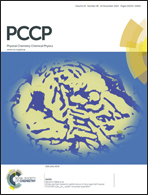Temperature sensing from the emission rise times of Eu3+ in SrY2O4
Abstract
The emission rise time of Eu3+-doped SrY2O4 was investigated in the temperature range of 20–200 °C for application in luminescence thermometry. After pulsed excitation, the energy transfer between the adjacent Eu3+ ions causes a emission build-up from the 5D0 level of Eu3+ and a notable emission rise occurs prior to decay. The emission rise-time values linearly decrease with temperature, providing an absolute sensitivity of 0.66 μs °C−1 and a maximal relative sensitivity of 5.53% °C−1 at 200 °C, for samples containing 0.5 at% Eu3+ ions. It is shown that the time after excitation at which emission reaches a maximum (time-to-max) can also be exploited for temperature sensing, since it is easily measurable and shows a linear dependence with temperature.


 Please wait while we load your content...
Please wait while we load your content...